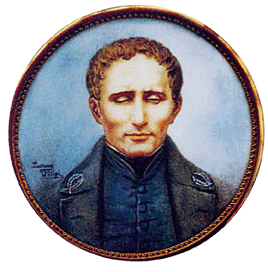When Louis Braille began developing his six-dot code for blind readers, he didn’t just want to use it to read books. He taught music and played the piano, organ, and cello, so he also created a way to read and write music. Do you play a musical instrument or like to sing? Do you read music? Thanks to Louis Braille, children who are blind can learn to read and write music braille, just like sighted children learn to read and write print music. There have been several famous blind musicians including Stevie Wonder, Andrea Bocelli, and Ray Charles.
Literary braille and music braille look a lot alike. Many of the symbols used to write braille letters are also used to write music braille notes and symbols. However, their meanings are different. For example, in the literary braille code, dots 1-4-5 Dots 1 4 5 represent the print letter D. In music braille those dots are the musical note C. Louis Braille didn’t use letter names for notes like many students do today; instead, he used the names of musical tones, beginning with “do” (pronounced “doe,” just like the song in the movie The Sound of Music). Because of this, he used the braille letter D to represent the first musical tone, and he developed the rest of the music braille code from there. Look below to see the braille dots for each note, its letter name, and its musical name.
music staff with notes from C to B

|
Types of Notes
In Music class, you’ve probably learned about quarter notes, half notes, whole notes, and eighth notes. Maybe your teacher has talked about what these notes look like. For example, print eighth notes have “flags” or “beams,” and print quarter notes are filled in. Braille notes don’t have flags or noteheads that are hollow or filled in. Instead, the position of dots in the braille cell tells a braille reader what kind of note he or she is reading. The top part of the cell tells the name of the note and bottom part (dots 3 and 6) tells about the rhythm or how long a note is held.
Here’s how it works:![]()
![]() Eighth Notes: No extra dots are added to the note.
Eighth Notes: No extra dots are added to the note.![]()
![]() Quarter Notes: A dot 6 is added to the note.
Quarter Notes: A dot 6 is added to the note.![]()
![]() Half Notes: A dot 3 is added to the note.
Half Notes: A dot 3 is added to the note.![]()
![]() Whole Notes: Dots 3 and 6 are added to the note.
Whole Notes: Dots 3 and 6 are added to the note.
Look at the notes below and see if you know what notes they are. (Braille readers, you can right-click here to download a braille file with the same musical notes.) Check the answer key to see if you’re right.
|
|
Other Musical Symbols
Print music has many other symbols, and most of these are represented in music braille. However, some very familiar print symbols are not found in braille. For example, the five-line musical staff, on which print notes are placed, is not used in braille. Instead, music braille characters are written in braille lines using special formats so that they are easy to read and give the braille reader all the information that is shown visually on the staff. The print music symbols for clefs, such as the Treble Clef and Bass Clef, are also not used in braille.
In piano music, a two-character symbol, play with the right hand, placed at the beginning of a music braille line, tells the reader to play with the right hand. A similar two-character sign, play with the left hand, tells the reader to play with the left hand. Finally, music braille does not have bar lines, which are used in print to divide music into measures, making it easier to read. Instead, a blank space represents a bar line.
A rest is a kind of musical symbol that you will find in both print and braille. When you play or sing music, you often have rests, which direct you to be silent for a short time. Just like in print, there are braille symbols that represent the different types of rests.
|
|||||||||||||||
|
This is the music, written in braille, for a popular children’s song. Each group of braille symbols represents a measure of music. Do you know what song it is? (Braille readers, you can right-click here to download a braille file with the same musical phrase.) After you think you know, check the answer key. |
|


